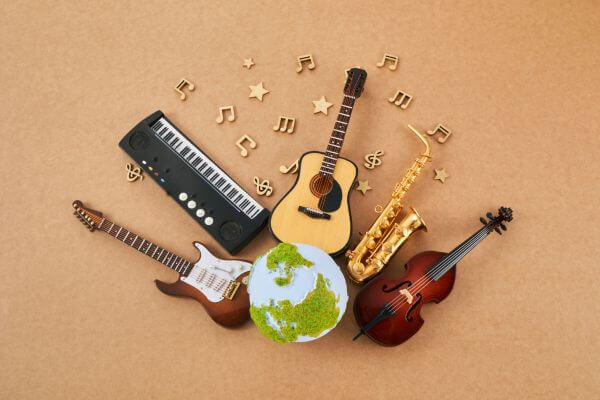The evolution of musical genres from classical to contemporary reflects a fascinating journey through humanity’s cultural history. From the intricate harmonies of classical compositions to the vibrant and innovative rhythms of contemporary music, each era has shaped the soundscape of its time.
More than mere artistic expression, music serves as a mirror of social, political, and technological transformations over the centuries. Exploring musical genres from classical to contemporary is an invitation to delve into a rich and diverse universe where each style tells a unique story.
This article will trace the development of musical genres, analyzing their characteristics, influences, and how they have shaped the way we listen to and experience music today. Prepare for a sonic journey that seamlessly connects the past to the present in an engaging and educational way.
The Classical Era Harmony and Sophistication
Origins of Classical Music
Classical music emerged between the 17th and 19th centuries, characterized by its complexity and balance. Composers like Bach, Mozart, and Beethoven were masters at translating human emotions into symphonies, operas, and concertos. This art form was predominantly elitist, performed in luxurious halls for the aristocracy.
A Lasting Legacy
The impact of classical music endures to this day, with orchestras worldwide preserving timeless works. It laid the foundation for many aspects of modern music, such as melodic structure and the use of instruments like the piano and violin. Thus, the evolution of musical genres from classical to contemporary began with a strong base of innovation and mastery.
From Folk to Blues Voices of the People
Folk Music and Cultural Traditions
Folk music emerged as an expression of local cultures, reflecting the stories, struggles, and celebrations of communities around the world. With simple melodies and meaningful lyrics, it became the voice of the people during both joyous and challenging times.
The Birth of Blues
By the late 19th century, the blues arose in the United States, deeply rooted in African American musical traditions. Its soulful lyrics and captivating rhythms directly influenced the creation of other genres such as jazz and rock. This pivotal moment in history underscores how the evolution of musical genres from classical to contemporary is driven by creativity and cultural resilience.
The Jazz Revolution and the Rise of Rock
Jazz Freedom and Improvisation
Born in the early 20th century, jazz introduced an innovative approach to music. Emphasizing improvisation and individual expression, artists like Louis Armstrong and Duke Ellington revolutionized how music was composed and performed.
Rock Rebellion and Innovation
In the 1950s, rock emerged as a symbol of youth and social defiance. Blending blues, country, and elements of jazz, artists like Elvis Presley and Chuck Berry transformed the global music scene. This era marked a significant turning point in the evolution of musical genres: from classical to contemporary, solidifying rock as a cultural phenomenon.
The Digital Era and Contemporary Diversity
Electronic Music and Digital Production
With the advent of digital technology in the late 20th century, electronic music gained prominence. DJs and producers like Daft Punk and Calvin Harris created new sounds using synthesizers and advanced software. This technological advancement paved the way for independent production and sonic experimentation.
Pop, Hip-Hop, and Musical Globalization
Pop and hip-hop have dominated the charts in recent decades, with artists like Beyoncé and Kendrick Lamar breaking cultural barriers and influencing social movements. Moreover, streaming platforms like Spotify and YouTube have democratized access to music, enabling artists from all corners of the globe to share their creations.
Current Trends and the Future of Music
Music as a Sensory Experience
Today, there is a growing fusion of genres and an emphasis on immersive experiences. Video game soundtracks, for instance, are being recognized as art, while live performances incorporate augmented reality to captivate audiences.
Artificial Intelligence in Music
With advancements in artificial intelligence, the future promises even greater personalization in music creation and interaction. AI tools are already being used to compose melodies and tailor playlists, offering new perspectives on the evolution of musical genres: from classical to contemporary.
Concluding about The Evolution of Musical Genres From Classical to Contemporary
The evolution of musical genres from classical to contemporary is a rich narrative that reveals how music reflects the essence of each era. From the masterfully composed works of classical music to the digital innovations defining contemporary sounds, each genre has its own story and impact.
By exploring this journey, we understand that music is much more than entertainment; it is a universal language that connects cultures, inspires movements, and transforms lives. Whether appreciating a Beethoven symphony or a hip-hop beat, we are all part of this vibrant and dynamic legacy.

